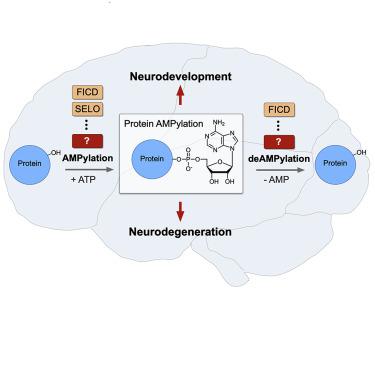Cell Chemical Biology ( IF 6.6 ) Pub Date : 2020-06-09 , DOI: 10.1016/j.chembiol.2020.05.009 Stephan A Sieber 1 , Silvia Cappello 2 , Pavel Kielkowski 3

|
Protein post-translational modifications (PTMs) are implicated in numerous physiological processes and significantly contribute to complex regulatory networks of protein functions. Recently, a protein PTM called AMPylation was found to play a role in modulation of neurodevelopment and neurodegeneration. Combination of biochemical and chemical proteomic studies has uncovered the prevalence of this PTM in regulation of diverse metabolic pathways. In metazoans, thus far two protein AMP transferases have been identified to introduce AMPylation: FICD and SELO. These two proteins were found to be involved in unfolded protein response and redox homeostasis on the cellular level and in the case of FICD to adjust the development of glial cells and neurons in Drosophila and cerebral organoids, respectively. Together with findings on AMPylation and its association with toxic protein aggregation, we summarize in this Perspective the knowledge and putative future directions of protein AMPylation research.
中文翻译:

从年轻到老:AMPylation击中大脑。
蛋白质翻译后修饰(PTM)与许多生理过程有关,并极大地促进了蛋白质功能的复杂调控网络。最近,发现一种叫做AMPylation的蛋白PTM在调节神经发育和神经变性中起作用。生化和化学蛋白质组学研究的结合发现了这种PTM在调节各种代谢途径中的普遍性。到目前为止,在后生动物中,已经确定了两种蛋白质AMP转移酶来引入AMPylation:FICD和SELO。发现这两种蛋白质在细胞水平上参与了展开的蛋白质反应和氧化还原稳态,在FICD的情况下,它可以调节果蝇中的胶质细胞和神经元的发育。和脑类器官。连同有关AMPylation及其与毒性蛋白质聚集的关系的发现,我们在本《观点》中总结了蛋白质AMPylation研究的知识和可能的未来方向。











































 京公网安备 11010802027423号
京公网安备 11010802027423号